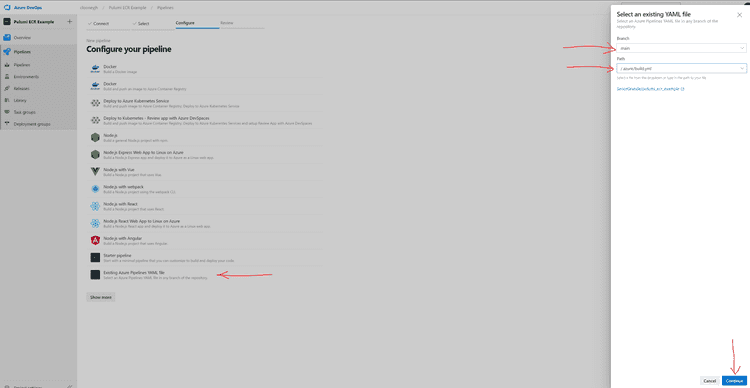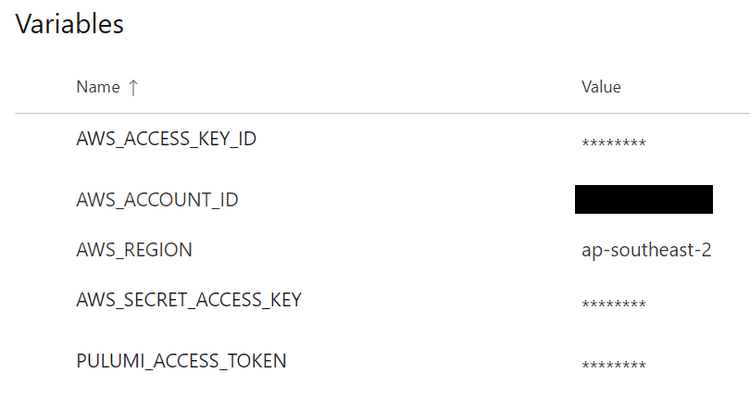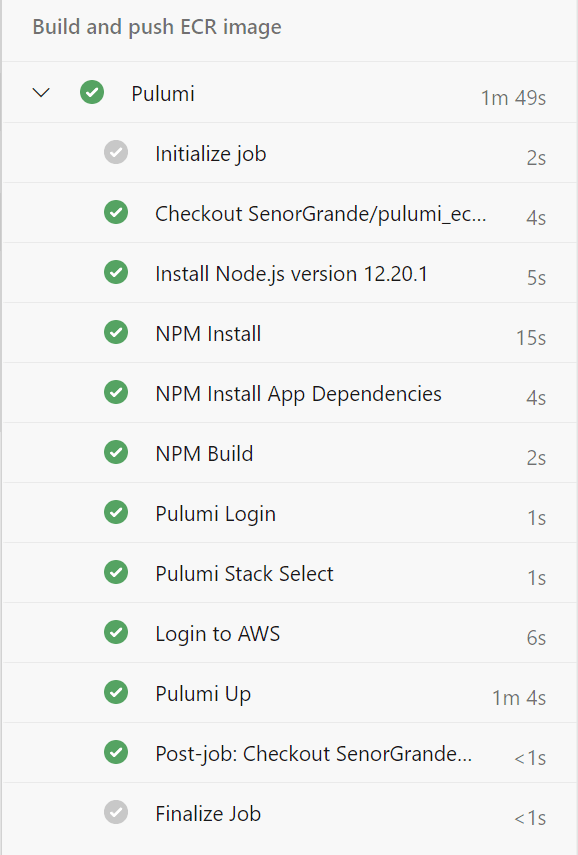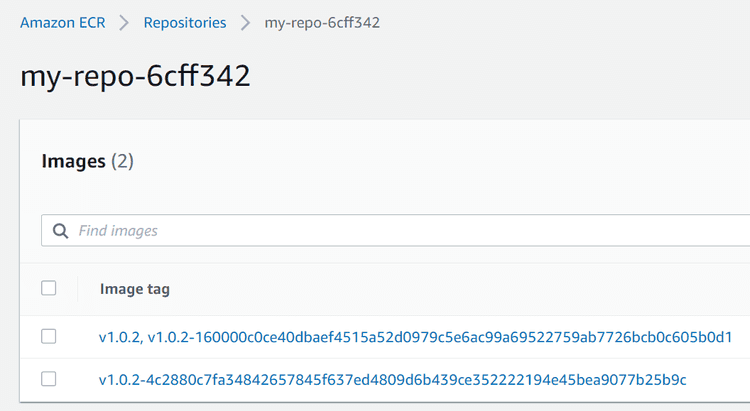CJ's Cloud City...
Build and Push a Docker image to AWS ECR with Pulumi : Part 2 (with Azure DevOps)
2021-11-14

In Part 1, we created a Pulumi project to create and AWS ECR repository and then build and push a Docker image to the newly created repo. In this sequel, we will create an Azure DevOps Pipeline to automate the CI process for us.
In Part 3, we will add Semantic Release to automate versioning of the image with each run of the pipeline, as this pipeline will only tag the Docker image with the hard-coded version defined in the repo.
Create the YAML for the pipeline
Create a folder called .azure in the repo we created in “Part 1” with a file named build.yml with the following code.
Important things to note about this pipeline:
- This pipeline will only trigger on commits to the
mainbranch - It pulls in a library called
Build
When the pipeline runs it will:
- Install Node.js 12.20.1
- Install NPM packages in the root directory of the repo (dependencies for the Pulumi project
- Install NPM packages in the
appdirectory (dependencies for the Node.js app that will be built into a Docker image) - Build the Node.js app in the
appdirectory - Login to Pulumi (with an access token from the
Buildlibrary) - Select the Pulumi stack in our Pulumi account to use (and create it if it doesn’t already exist)
- Login to AWS ECR so that an image can be pushed to the repo (using the AWS credentials in the
buildlibrary) - Run
pulumi upto create an ECR repository if it doesn’t already exist, then build and push a Docker image to it.
# Trigger on any push to main
trigger:
- main
pr: none
pool:
vmImage: ubuntu-20.04
variables:
- group: "Build"
stages:
- stage: Build
displayName: Build and push ECR image
jobs:
- job: Pulumi
steps:
- task: NodeTool@0
inputs:
versionSpec: 12.20.1
displayName: 'Install Node.js version 12.20.1'
- task: Bash@3
name: npmInstall
displayName: NPM Install
inputs:
targetType: 'inline'
script: npm i
- task: Bash@3
name: npmInstallApp
displayName: NPM Install App Dependencies
inputs:
workingDirectory: $(Build.SourcesDirectory)/app
targetType: 'inline'
script: npm i
- task: Bash@3
name: npmBuild
displayName: NPM Build
inputs:
workingDirectory: $(Build.SourcesDirectory)/app
targetType: 'inline'
script: npm run build
- task: Bash@3
name: pulumiLogin
displayName: Pulumi Login
inputs:
targetType: 'inline'
script: pulumi login
env:
PULUMI_ACCESS_TOKEN: $(PULUMI_ACCESS_TOKEN)
- task: Bash@3
name: pulumiStackSelect
displayName: Pulumi Stack Select
inputs:
targetType: 'inline'
script: pulumi stack select dev -c --non-interactive
- task: Bash@3
displayName: 'Login to AWS'
inputs:
targetType: 'inline'
script: aws ecr get-login-password --region $(AWS_REGION) | docker login --username AWS --password-stdin $(AWS_ACCOUNT_ID).dkr.ecr.$(AWS_REGION).amazonaws.com
env:
AWS_ACCESS_KEY_ID: $(AWS_ACCESS_KEY_ID)
AWS_SECRET_ACCESS_KEY: $(AWS_SECRET_ACCESS_KEY)
- task: Bash@3
name: pulumiUp
displayName: Pulumi Up
inputs:
targetType: 'inline'
script: pulumi up -y
env:
AWS_ACCESS_KEY_ID: $(AWS_ACCESS_KEY_ID)
AWS_SECRET_ACCESS_KEY: $(AWS_SECRET_ACCESS_KEY)
Create a project and pipeline in Azure DevOps
Create a new project in Azure Devops. Once created and in the project, click on “Pipelines” and then “new pipeline”.

After clicking “new pipeline”, select GitHub and then choose your repo you would like to create your pipeline for.
In the third step, “Configure your pipeline”, select “Existing Azure Pipelines YAML file”.

Then choose the branch and path for the Azure Pipelines YAML file that you created in the previous step. ( main branch and ./azure/build.yml in my case).
Create Library “Build”
On the left-hand navigation bar in Azure DevOps, select “Library” in the “Pipelines” group and click on “+Variable Group”. Type in “Build” for the “Variable Group Name” (you can name it something else, but remember to change that name in the build.yml file where you pull in the variable group).
Add the following variables to your variable group:
- AWS_ACCESS_KEY_ID — The access key of the IAM creds that have access to ECR
- AWS_ACCOUNT_ID — The ID of your AWS account you’re deploying this to, I’ve censored mine for the sake of this article, but doesn’t need to be marked secret
- AWS_REGION — AWS region to create the ECR repo in, I’ve chosen Sydney
- AWS_SECRET_ACCESS_KEY — The secret key of the IAM creds that have access to ECR
- PULUMI_ACCESS_TOKEN — Access token created in your Pulumi account (check “Settings” > “Access Tokens” to create one)

Run the Pipeline
Run the pipeline manually or push a new commit to the main branch to trigger a run.

This will push an image with the version hard-coded in the repo (Pulumi will also add a second tag with a unique string appended to the original tag string). Subsequent runs of the pipeline will result in only the latest image having the hard-coded tag (in this case v1.0.2). We will make this dynamic in “Part 3” of this series, so stay tuned!

Hoped this helped, Bonza 🤙